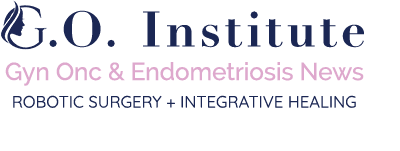The G.O. Institute investigative team looks for potential new advances in endometriosis research. These days, the focus is on genomic and molecular alterations that can be used to treat diseases and there is a big interest in the endometriosis area as well. When gene alterations are found the idea is to target them with biological agents to change how these genes are expressed. This is called epigenetics and while we look for medications that can influence genes it’s important to know that epigenetic influences are also based on nutrition and lifestyle choices. So, this type of research helps define who might get endo and how it might be reversible.
Environmentally influenced epigenetic changes have also been associated with many diseases such as cancer and neurodegenerative disorders, with patients that do not respond or only poorly respond, to conventional therapy. It is clear that disorders based on an individual’s personal genomic/epigenomic profile can rarely be successfully treated with standard therapies due to genetic heterogeneity and epigenetic alterations and a personalized medicine approach is far more appropriate to manage these patients.
The following laboratory study looked at how estrogen levels might be high in endometriosis and surrounding cells, even if estrogen levels in the body are not abnormally elevated. The point is that at the tissue level, biochemical machinery is in play that can’t be influenced simply by “balancing hormones” via artificially taking progesterone creams, bio-identical or otherwise.
“Endometriosis is a common chronic inflammatory disease in which endometrial tissue appears outside of the uterine cavity. Since ectopic endometriosis cells express both estrogen and progesterone (P4) receptors, they grow and undergo cyclic proliferation and degradation similar to the endometrium. This debilitating gynecological condition affects up to 15% of women of childbearing age. Despite years of research, the etiopathogenesis of endometrial lesions remains unclear. The retrograde transport of viable menstrual endometrial cells with retained ability to adhere in the pelvic cavity, proliferation, differentiation, and subsequent invasion into surrounding tissue forms the basis of a generally accepted theory of implantation. Accordingly, the most common cells in the endometrium are endometrial stromal cells (EnSCs). These cells represent a distinct population with clonogenic activity that resembles the properties of mesenchymal stem / stromal cells (MSCs). Therefore, stem cell-based dysfunction is believed to play a significant role in the formation of the initial endometrial lesions. There is increasing evidence that the role of epigenetic mechanisms and processes in endometriosis has been underestimated. The role of excessive estrogen exposure and P4 resistance in failure of epigenetic homeostasis in endometrial / endometriotic tissue is critical. Epigenetic changes in the transcription factors of estrogen and P4 signaling pathways in MSCs are robust in endometriotic tissue. Future prospects could therefore include MSCs and EnSCs as targets for epigenetic therapies in the prevention and treatment of endometriosis. Here we have examined the currently known changes in the epigenetic background of EnSCs and MSCs due to estrogen / P4 imbalances associated with the etiopathogenesis of endometriosis. Graphic summary.
Read more using the link below. At the G.O. Institute, we are available to help you get relief from endometriosis using advanced robotics, conventional medicine and integrative healing.
References
-
- Kim, JH & Han, E. (2018). Endometriosis and female pelvic pain. Seminars in Reproductive Medicine, 36 (2), 143–151. https://doi.org/10.1055/s-0038-1676103. – DOI – PubMed
- C. Bourgioti, O. Preza, E. Panourgias, K. Chatoupis, A. Antoniou, ME Nikolaidou & LA Moulopoulos (2017). MR imaging of endometriosis: spectrum of diseases. Diagnostic and Interventional Imaging, 98 (11), 751-767. https://doi.org/10.1016/j.diii.2017.05.009. – DOI – PubMed
- D. Charatsi, O. Koukoura, IG Ntavela, F. Chintziou, G. Gkorila, Tsagkoulis et al. (2018). Gastrointestinal and Urinary Tract Endometriosis: An Overview of the Most Common Locations of Extra-Pelvic Endometriosis. Advances in Medicine, 2018, 3461209. https://doi.org/10.1155/2018/3461209. – DOI – PubMed – PMC
- Chamié, LP, Ribeiro, D., Tiferes, DA, Macedo Neto, AC & Serafini, PC (2018). Atypical sites of deep infiltrative endometriosis: clinical features and imaging findings. Radiographics: a review publication from the Radiological Society of North America, Inc, 38 (1), 309-328. https://doi.org/10.1148/rg.2018170093. – DOI
- N. Machairiotis, A. Stylianaki, G. Dryllis, P. Zarogoulidis, P. Kouroutou, N. Tsiamis et al. (2013). Extra-Pelvic Endometriosis: A Rare Entity or an Underdiagnosed Condition? Diagnostic Pathology, 8, 194. https://doi.org/10.1186/1746-1596-8-194. – DOI – PubMed – PMC
